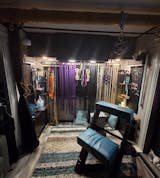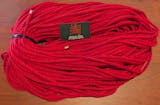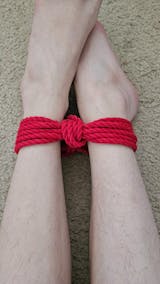About jute rope
Feb 10, 2021
What do the numbers mean on the jute rope?
Or, way more about jute than you really wanted to know.
deGiotto Rope - What do the numbers on jute rope/yarn mean? from deGiotto Rope on Vimeo.
In short, jute designations such as 12/1 refer to the thickness of the yarn used to make the rope. The larger the number in front of the slash, the thicker the yarn. 12/1 is a thicker yarn than 8/1.
The number after the slash is the number of plies in the yarn. 12/1 is a single-ply yarn. 10/2 is a 2-ply or double-ply yarn. When you untwist a single-ply yarn, you get jute fibers. When you untwist a 2-ply yarn, you get two single-ply yarns.
What does that mean to you, the bondage rope user? Basically, the thicker the yarn and the more plies it has, the more durable the rope. Thinner yarn with fewer plies is more flexible, lighter and moves easier. Ropes made with thicker yarn generally last longer than those made with thinner yarn. Ropes made with thinner yarn are smoother and make turns faster.
DGR standard lay jute ropes in order of durability: 10/2, 12/1 natural, 12/1 colors, 8/1 blonde.
DGR standard lay jute ropes in order of flexibility: 8/1 blonde, 12/1 colors, 12/1 natural, 10/2.
All DGR jute ropes are made with the highest grade jute yarns. Those yarns are spun using vegetable oil. They have no kerosene smell.
Now the more that you might want to know part.
Very little, if any, of the information to follow might affect your buying decision. It’s here because it’s cool to know and gives us rope geeks something to talk about.
Any string, twine, cord etc. used to make rope is referred to as yarn.
What do the numbers for jute yarn mean exactly? Where do they come from?
Yarn as opposed to wire is squishy. It’s hard or impossible to measure the thickness of yarn as a diameter or gauge. When you try to use something like a caliper to measure it, it compresses and flattens. Even the highest quality and best spun yarns have variation in them continuously throughout their length. Trying to use a ruler or even a digital optical measuring device is ineffective because the measurement changes slightly inch to inch.
Throughout the textile industry, yarn is measured as a ratio of length to weight, or weight to length. There are dozens of systems of these types of measurements. Almost one for every type of fiber. A few standards have developed over the years but they don’t encompass all the different materials yarn is made from.
Limiting our discussion, jute yarn thickness is measured by how many pounds does 14,400 yards of yarn weigh. Where they came up with 14,400 yards I have no idea. Even converting to obscure English measurements like furlough and league doesn’t seem to make a reasonable conversion. Moving on.
So a 12/1 jute yarn is a single-ply yarn that given 14,400 yards would weigh 12 pounds.
14,400 feet of 10/2 jute yarn would weigh more than 20 pounds. Here’s why. A 10/2 yarn is composed of two 10/1 yarns. 14,400 feet of each yarn would weigh 10 pounds. However, the twisting shortens the length so you would need more than 14,400 feet of each yarn to make 14,400 feet of the yarn consisting of the plies twisted together.
The take-away here is, jute is frickin’ light!
Some other cool to know things about the quality of jute yarn.
Types of jute
Jute fiber is usually made from the stalk of one of two jute species. White jute (Corchorus capsularis) and Tossa (chorchorus olitorius). Both are grown in parts of India and Bangladesh. Tossa makes a lighter and stronger fiber. The softest and finest fibers of the Tossa jute stem are a golden to reddish color.
Grades of fiber
The finest grade of jute fiber is Bangla Tossa Special (BTS). It is characterized with the following properties:
- ·Uniform golden or reddish color
- ·Finest texture
- ·Very strong
- ·Very good luster
- ·Clean cut and well hackled
- ·Completely free from any defects
Grades of yarn
Jute yarn is used for hundreds of purposes. The two principle ones are making bags and the cloth that is the backer for carpets and rugs. The grading of jute yarn reflects these two uses.
Hessian (HQ) characterized by rough thick fibers of low quality. Used to manufacture burlap bags.
Sacking (SQ) medium to high grade fibers spun roughly. Used for sacks for produce.
Carpet backing (CB) used as stated in the name. Made from the highest grade fibers.
There are designations for different types of carpet backing yarn that refer to the types of weaving machines they are suitable for. CRX being the cleanest and most consistent.
Jute Batching Oil or Why does that cheap jute rope I bought smell like kerosene?
Jute fibers are stiff. They must be lubricated to spin together evenly and to bend through the spinning machinery without breaking or wearing out the machines. The lubricant used is a mix of Water-80%, Jute batching oil-19% and Emulsifier-1%. In most yarn production Jute Batching Oil, or JBO, is a light petroleum oil like mineral oil. This light oil is suspected to be a carcinogenic and it smells awful. The smell is usually described as kerosene.
For jute that is going to come into contact with food, like produce sacks, a vegetable oil, usually castor oil is used as the JBO. This is known as Vegetable Oil Treated or VOT jute. It is also known as Food Grade.
In summary:
DGR jute ropes whether 8/1, 12/1, or 10/2 are made from CRX VOT 100% Tossa jute yarns. Now you know what that means.
http://www.servicethread.com/t
http://textilelearner.blogspot
https://textileapex.blogspot.c
http://fashion2apparel.blogspo
http://www.jute.cotheeka.com/f
I am by no means a textiles expert. I am open to being corrected on anything above.



2 comments
Ok. Finally found it. The choice of lay/tightness is only found in the 300’ uncut sets
This goes well with the previous comment
You mention 10/2, 12/1, and 8/1 based on your wording you’re using 12/1 (natural & color) I don’t see any other descriptions of your rope in choices. The only choice I see is a loose lay and no tighter lays. Did you stop making a larger variety or am I missing the choices. I know a lot of people like a tighter lay. Also saying the tighter lay ends up being more durable. Makes sense. A tighter twist packs more fibers into each foot.